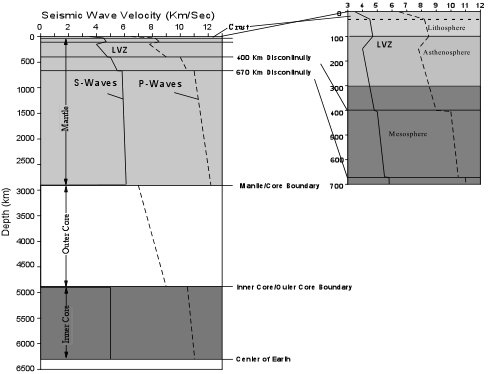
| EENS 2120 |
Petrology |
| Tulane University |
Prof. Stephen A. Nelson |
|
Structure of the Earth and the Origin of Magmas |
|
| Magmas do not form everywhere beneath the surface of the Earth. This
is evident from looking at the world distribution of volcanoes. Thus, magmas must require
special circumstances in order to form. Before we talk about how and where magmas
form, we first look at the interior structure of the Earth.
The Earth's Internal Structure Evidence from seismology tells us that the Earth has a layered structure. Seismic waves generated by earthquakes travel through the Earth with velocities that depend on the type of wave and the physical properties of the material through which the waves travel. Types of Seismic Waves
|
 |
Once we know the seismic wave velocities throughout the Earth, then we can perform experiments on different possible materials and make estimates of what the chemical composition. Thus, we can also divide the Earth into layers of differing chemical composition.
|
Layers of Differing Chemical Composition
|
Layers of Differing Physical Properties Lithosphere - about 100 km thick (up to 200 km thick beneath
continents, thinner beneath oceanic ridges and rift valleys),
very brittle, easily fractures at low temperature. Note that the
lithosphere is comprised of both crust and part of the upper mantle. The
plates that we talk about in plate tectonics are made up of the lithosphere, and appear to
float on the underlying asthenosphere.
Asthenosphere - about 250 km thick - solid rock, but soft and
flows easily (ductile). The top of the asthenosphere is called the Low
Velocity Zone (LVZ) because the velocities of both P- and S-waves are lower
than the in the lithosphere above. But, not that neither P- nor S-wave velocities go
to zero, so the LVZ is not completely liquid.
Mesosphere - about 2500 km thick, solid rock, but still capable of
flowing. Outer Core - 2250 km thick - liquid. We know this
because S-wave velocities are zero in the outer core. If Vs = 0,
this implies μ = 0, and this implies that the material is
in a liquid state. Inner core - 1230 km radius, solid |
Magmas are not likely to come from the only part of the Earth that is in a liquid state, the outer core, because it does not have the right chemical composition. The outer core is made mostly of Fe with some Ni, magmas are silicate liquids. In the ocean basins, magmas are not likely to come from melting of the oceanic crust, since most magmas erupted in the ocean basins are basaltic. To produce basaltic magmas by melting of the basaltic oceanic crust would require nearly 100% melting, which is not likely. In the continents, both basaltic and rhyolitic magmas are erupted and intruded. Basaltic magmas are not likely to have come from the continental crust, since the average composition is more siliceous, but more siliceous magmas (andesitic - rhyolitic) could come from melting of the continental crust. Basaltic magmas must come from the underlying mantle. Thus, with the exception of the continents, magmas are most likely to originate in the mantle from melting of mantle peridotite. |
Again, magmas do not form everywhere beneath the surface, so special circumstances are necessary. |
| Temperature varies with depth or pressure in the Earth along the geothermal gradient. The normal geothermal gradient is somewhat higher beneath the oceans than beneath the continents, at least at shallow levels. If we compare the normal geothermal gradients with the experimentally determined phase diagram for peridotite containing little water or carbon dioxide, we find that the peridotite solidus temperature is everywhere higher than the normal geothermal gradients. Thus, under normal conditions the mantle is solid, as we would suspect from the seismic evidence. |
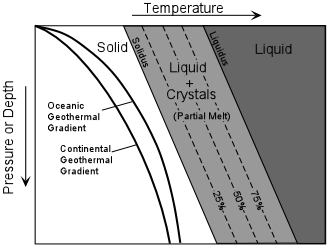 |
| Thus, in order to generate a melt, either we must find a way to increase the geothermal gradient so that it is above the peridotite solidus or reduce the temperature of the peridotite solidus. In either case note that all we have to do is get the temperature in some part of the Earth, as expressed by the geothermal gradient, into the field of partial melt. Partial melting is the most likely case because it requires less of an increase in temperature or less of a decrease in the peridotite solidus. Once a partial melt has formed, the liquid portion can be easily separated from the remaining solids since liquids are more mobile and, in general, have a lower density than solids. |
| Raising the Geothermal Gradient
|
|
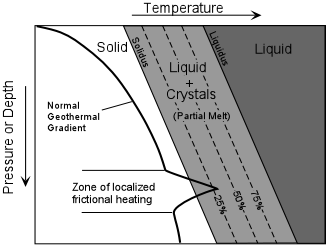 |
|
The rate of convection depends on both on the temperature gradient and the viscosity
of the material (note that solids convect, but the rate is lower than in liquids because
solids have higher viscosity). In the Earth, temperature gradients appear to be high
enough and viscosity low enough for convection to occur. Plate tectonics appears to
be driven by convection in some form. |
 |
Anywhere there is a rising convection current, hotter material at depth will rise carrying its heat with it. As it rises to lower pressure (decompression) it will cool somewhat, but will still have a temperature higher than its surroundings. Thus, decompression will result in raising the local geothermal gradient. If this new geothermal gradient reaches temperatures greater than the peridotite solidus, partial melting and the generation of magma can occur. This mechanism is referred to as decompression melting. |
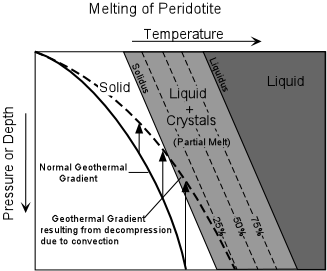 |
| Lowering the Solidus Temperature
As we saw in our discussion of phase diagrams, mixtures of components begin melting at a lower temperature than the pure components. In a two component system addition of a third component reduces both the solidus and liquidus temperatures. This suggests that if something can be added to the mantle, it could cause the solidus and liquidus temperatures to be lowered to the extent that the solidus could become lower than the geothermal gradient and result in partial melting, without having to raise the geothermal gradient. Such a melting mechanism is referred to as flux melting.
It's difficult to imagine how solid components could be added to the mantle. But volatile components, for example H2O and CO2, because of their high mobility, could be added to the mantle, particularly at subduction zones. |
|
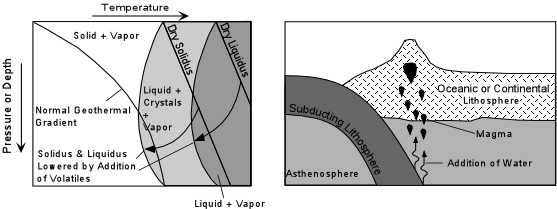 |
| Crustal Anatexis In the continental crust, it is not expected that the normal geothermal gradient will be high enough to cause melting despite the fact that hydrous and carbonate minerals occur in many continental rocks. Furthermore, because continental rocks are at low temperature and have a very high viscosity, convective decompression is not likely to occur. Yet, as we will see, there is evidence that continental crustal rocks sometimes melt. This is called crustal anatexis. The following scenario is one mechanism by which crustal anatexis could occur. |
|
|
Magmatism and Plate Tectonics From the discussion above it should be obvious that magmatism is closely related to plate tectonics. The diagram below summarizes melting mechanisms that occur as a result of plate tectonics and may be responsible for the generation of magmas in a variety of plate tectonic settings, such as oceanic ridges, near subduction zones, and at rift valleys. |
|
Diverging Plate Boundaries Diverging plate boundaries are where plates move away from each other. These include oceanic ridges or spreading centers, and rift valleys.
|
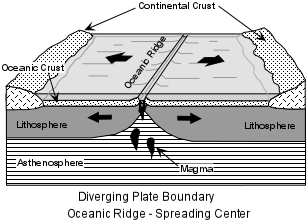 |
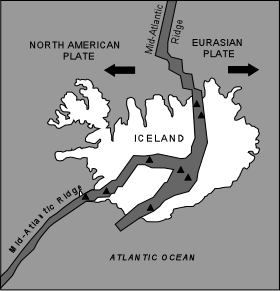 |
|
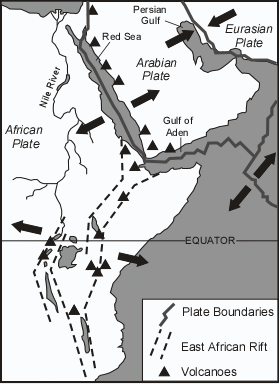 |
Converging Plate Boundaries Converging plate boundaries are where plates run into each other. The most common type are where oceanic lithosphere subducts. Several mechanisms could contribute to the generation of magmas in this environment (see diagram at top of this section).
|
|
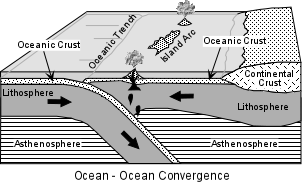 |
|
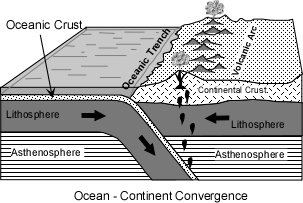 |
|
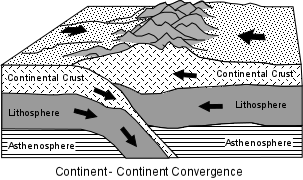 |
Intraplate Magmatism & Hot Spots There are a few areas where
magmatism does not appear to be related to converging or diverging plate boundaries.
These areas occur in the middle of plates, usually far from the plate boundaries.
This phenomenon is referred to as intraplate magmatism.
Intraplate magmatism is thought to be caused by hot spots formed
when thin plumes of mantle material rise along narrow zones from deep within the mantle.
The hot spot remains stationary in the mantle while the plate moves over the hot
spot. |
| Decompression melting caused by the upwelling plume produces magmas that form a volcano on the sea floor above the hot spot. The volcano remains active while it is over the vicinity of the hot spot, but eventually plate motion results in the volcano moving away from the plume and the volcano becomes extinct and begins to erode. | 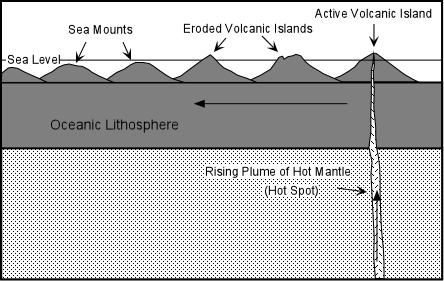 |
| Because the Pacific Plate is one of the faster moving plates, this type of volcanism produces linear chains of islands and seamounts, such as the Hawaiian - Emperor chain, the Line Islands, the Marshall-Ellice Islands, and the Austral seamount chain. |
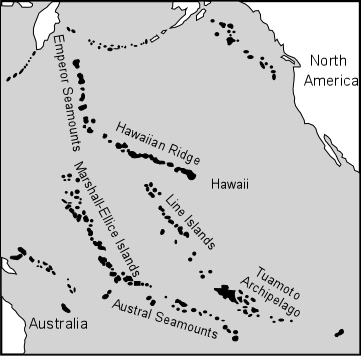 |
Examples of questions on this material that could be asked on an exam
|